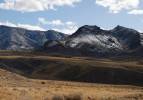Green burials approach recycling naturally
Many of the benefits of green living are in real time. We enjoy them as they happen. Paying less money at the gas pump or for a utility bill can be a rewarding activity these days. Our lives also are enhanced by green buildings or by making healthy dietary choices. In my humble opinion, however, the greatest benefits are those that accrue over time as a result of our collective actions.
A lifetime of environmentally responsible living impacts others in myriad ways, but the overall effect is that of living in greater harmony with the world. Every decision, large or small, can be like a deposit into our collective green savings account. The returns on our green investments show up as cleaner air and water, less pollution, healthy forests and, well, you get the picture.
We all return to our ultimate home at the end of our lives. It is the cycle of life. There is a growing trend in many countries, including the U.S., that provides a way to make that final act as green as possible. Eco-friendly green burials are catching on.
Simply speaking, green burials are a way to return to the earth in a natural way. It is the ultimate act of recycling. There is more to the story since the concept of green burial goes much deeper (no pun intended).
I recently visited a very interesting and beautiful place nestled in the headlands of Marin County, just minutes north of San Francisco. Forever Fernwood is one of several facilities in the U.S. that specializes in green burials. It is the site of a small cemetery that dates back to the 1800s. Much of the surrounding land, 32 acres in all, consists of hilly woodlands and meadows. It looks more like a nature preserve than a cemetery. And that is exactly the intent. A plaque from the National Wildlife Federation hangs near the door proclaiming that the site is a certified wildlife habitat.
Many areas have been invaded by nonnative vegetation that has changed the balance of the environment, often with undesirable results. At Forever Fernwood, they are patiently restoring the land. Over time, nonnative eucalyptus trees are being removed. When someone chooses to plant a memorial tree in lieu of a gravestone, indigenous trees are used instead. Thus the landscape slowly reverts to its original state and native wildlife flourishes. Those who are laid to rest there become a part of the natural beauty and the ongoing cycle of life.
Natural burials forgo the toxic chemicals, including formaldehyde, that are part of the embalming process. In the U.S., more than 800,000 gallons of embalming fluid enter the environment each year. Simple caskets or burial shrouds made from natural materials reduce the environmental impact even more. Rather than gravestones, sites are recorded using GPS coordinates that provide precise location information for visitors.
Green burials also eliminate the need for expensive caskets and concrete liners used in traditional cemeteries. Each year in the U.S. traditional burials use approximately 30 million board feet of lumber (including endangered tropical hardwoods), 90,000 tons of steel and more than 1.6 million tons of concrete. These resources are used once, never to be recycled, and they contain a very large amount of embodied energy which contributes to the problem of climate change.
The green approach eliminates chemical pesticides, fertilizer and the tremendous amounts of water needed to maintain green lawns. This is a critical issue in the Mojave Desert.
I've discovered that the process of cremation also has a significant environmental footprint. It takes an incredible amount of energy, usually derived from fossil fuels, to complete the long, high-temperature process, thus adding additional carbon dioxide to the atmosphere. Other toxins including dioxin, hydrochloric acid, hydrofluoric acid, sulphur dioxide and mercury are released as well. This is a burden on the environment that we can choose to avoid.
Returning to the earth is as natural as it gets and has been the norm for millennia. Complex, expensive and environmentally damaging methods are a relatively recent phenomena in our society. The idea of making a final green statement through the act of a simple, environmentally responsible green burial appeals to a growing number of people. In fact, more than 70 percent of the participants in an AARP poll chose green burial over traditional methods, including cremation.
Everyone will make his or her own personal decision on this topic. My experience walking across the hillside meadow at Forever Fernwood was peaceful, inspired by the natural beauty of the land. It felt right.
Thankfully the number of facilities that offer similar services is growing. I spoke to at least one local company that is exploring the concept. A good place to find more information is www.greenburials.org. Additional references will be posted on my Web site.
No matter how old one is, it is never too late to make green living a part of life ... and beyond.
Steve Rypka is a green living consultant and president of GreenDream Enterprises, specializing in renewable energy, green building, alternative transportation and lifestyle choices for both residential and commercial clients. The company is committed to helping people live lighter on the planet. Rypka can be reached via e-mail at steve@greendream.biz. More information relating to this column is posted at www.greendream.biz.























